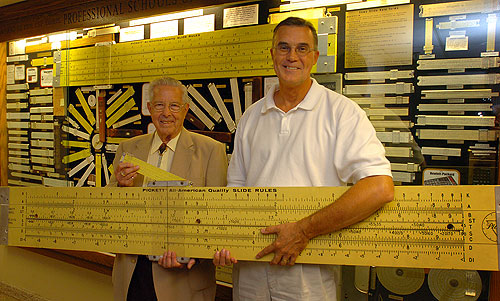Astronauts Neil Armstrong and Jerry Ross, along with about 200 other Purdue University alumni, have added their slide rules to a new exhibit at their alma mater that testifies to the past mathematical prowess of these computational devices.
The permanent display, on the first floor of the university's Potter Engineering Center, houses the pre-digital analytical marvels, some of which were made in the 19th century and range in length from a few inches to seven feet.

Above: Robert Miles, a retired Purdue University civil engineering professor and a Purdue alumnus, left, and James Alleman, a current Purdue civil engineering professor, hold a 7-foot-long slide rule in front of an exhibit they created that contains about 200 of the pre-digital computational devices. The permanent exhibit is on display in the university's Potter Engineering Center and includes slide rules from astronauts Neil Armstrong and Jerry Ross. (Purdue/David Umberger)
"There was a point in time when the slide rule was king," said James Alleman, a professor of civil engineering who began collecting the slide rules from alumni 15 years ago. "During a period of about 400 years, anything anybody built that was of any magnitude would have required a slide rule."
Then, in the early 1970s Hewlett Packard came out with the first commercial calculator, the HP-35, signaling an end to the slide rule's dominance in scientific computing.
Purdue alumnus and retired civil engineering professor Robert Miles fondly recalls the calculator's debut.
"We bought 10 HP-35s and had six installed in the civil engineering structures lab," said Miles, who helped design the display and paid for its construction. "Those six calculators were mysteriously missing within about two weeks, even though they were chained down."
Although calculators revolutionized the world of computation for engineers, scientists and students, they also introduced a disturbing educational trend.
"Many people who push the buttons on calculators don't really know what the numbers mean, while on a slide rule you had to analyze where the decimal point went, and you had to better understand the mathematics," said Miles, who taught civil engineering at Purdue for 40 years, retiring in 1990. He also holds a bachelor's degree and master's degree in civil engineering from Purdue.
"A slide rule gives you an amazing amount of computational ability, and people today don't even remember what these things are capable of doing," Miles said.
Alleman said he began collecting the slide rules out of personal interest and for a display to coincide with civil engineering's centennial celebration in 1987. The new glass-enclosed wall exhibit includes slide rules from four astronauts who are Purdue alumni: Armstrong, the first man to walk on the moon; Ross, who has logged more space-walking hours than any other astronaut; Richard Covey and Roy Bridges. Eugene Cernan, the last man to walk on the moon and also a Purdue alumnus, has promised to send his slide rule, as well.
"There are a lot of human stories here," Alleman said. "If these slide rules could talk - because of all the alumni who donated these things - I am sure they would each tell remarkable stories about projects they were used on."
The display, which is roughly 6 feet high and 12 feet long, "is sort of a history of slide rules," he said.
"Our gigantic 7-foot-long slide rules really catch your eye, and then as you get up close the display kind of pulls you in with the story that it tells," Alleman said.
The exhibit is arranged in a series of panels about the history of slide rules, recounting how English scientists developed the devices. It all began in 1614, when Scottish mathematician John Napier discovered the logarithm, with which multiplication and division could then be completed using addition and subtraction. Six years later, English mathematician Edmund Gunter created a number line in which the positions of numbers were proportional to their logarithms, and in 1632 fellow countryman William Oughtred used Gunter's approach to invent the first slide rule.
The display includes cylindrical slide rules and slide rules made of metal, wood, bamboo, paper and plastic.
The largest slide rules were used in classes to teach students how to use them, Miles said.
"Taking a course to learn how to use a slide rule was mandatory at one time," he said. "And from then on you used it for the rest of your academic career."













